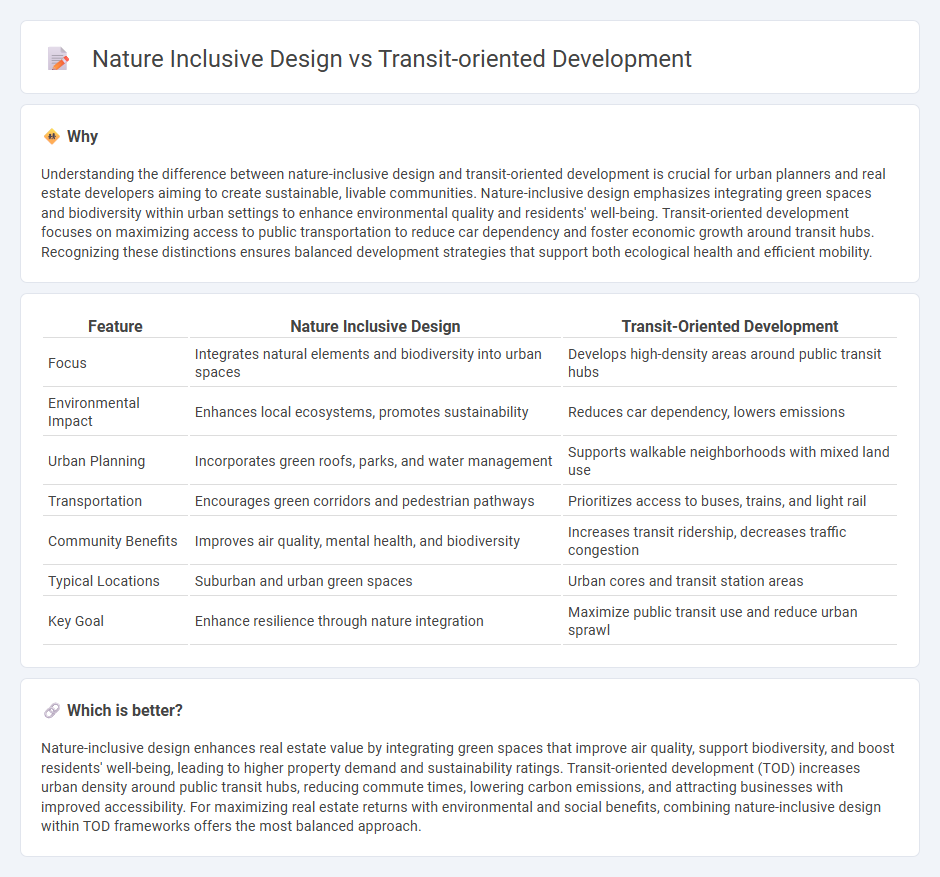
Nature-inclusive design integrates natural elements into urban real estate projects to promote sustainability and enhance biodiversity, improving residents' quality of life through green spaces and eco-friendly materials. Transit-oriented development focuses on creating high-density, walkable communities centered around public transit hubs, reducing reliance on cars and fostering economic growth. Explore more to understand how these approaches shape the future of urban living.
Why it is important
Understanding the difference between nature-inclusive design and transit-oriented development is crucial for urban planners and real estate developers aiming to create sustainable, livable communities. Nature-inclusive design emphasizes integrating green spaces and biodiversity within urban settings to enhance environmental quality and residents' well-being. Transit-oriented development focuses on maximizing access to public transportation to reduce car dependency and foster economic growth around transit hubs. Recognizing these distinctions ensures balanced development strategies that support both ecological health and efficient mobility.
Comparison Table
| Feature | Nature Inclusive Design | Transit-Oriented Development |
|---|---|---|
| Focus | Integrates natural elements and biodiversity into urban spaces | Develops high-density areas around public transit hubs |
| Environmental Impact | Enhances local ecosystems, promotes sustainability | Reduces car dependency, lowers emissions |
| Urban Planning | Incorporates green roofs, parks, and water management | Supports walkable neighborhoods with mixed land use |
| Transportation | Encourages green corridors and pedestrian pathways | Prioritizes access to buses, trains, and light rail |
| Community Benefits | Improves air quality, mental health, and biodiversity | Increases transit ridership, decreases traffic congestion |
| Typical Locations | Suburban and urban green spaces | Urban cores and transit station areas |
| Key Goal | Enhance resilience through nature integration | Maximize public transit use and reduce urban sprawl |
Which is better?
Nature-inclusive design enhances real estate value by integrating green spaces that improve air quality, support biodiversity, and boost residents' well-being, leading to higher property demand and sustainability ratings. Transit-oriented development (TOD) increases urban density around public transit hubs, reducing commute times, lowering carbon emissions, and attracting businesses with improved accessibility. For maximizing real estate returns with environmental and social benefits, combining nature-inclusive design within TOD frameworks offers the most balanced approach.
Connection
Nature-inclusive design enhances urban living by integrating green spaces and biodiversity within built environments, directly supporting transit-oriented development (TOD) which prioritizes accessible public transit hubs to reduce car dependency. By combining these approaches, real estate projects create sustainable, walkable communities that promote ecological health and efficient transportation networks. This synergy increases property values and attracts environmentally-conscious residents seeking convenience and natural amenities.
Key Terms
**Transit-oriented development:**
Transit-oriented development (TOD) prioritizes high-density, mixed-use communities centered around public transportation hubs to reduce car dependency and promote sustainable urban living. This approach enhances accessibility, lowers greenhouse gas emissions, and supports economic growth by integrating residential, commercial, and recreational spaces within walking distance of transit stations. Discover how TOD strategies reshape urban landscapes for smarter, greener cities.
Density
Transit-oriented development (TOD) emphasizes high-density urban growth near public transit hubs to reduce car dependency and promote sustainable mobility. Nature inclusive design integrates green infrastructure and biodiversity within these dense areas to enhance ecological benefits and improve residents' well-being. Explore more to understand how combining TOD with nature inclusive design creates resilient and vibrant urban environments.
Mixed-use zoning
Mixed-use zoning promotes transit-oriented development by integrating residential, commercial, and recreational spaces within walkable distances, reducing car dependency and enhancing public transit efficiency. Nature inclusive design within mixed-use areas prioritizes green infrastructure, biodiversity corridors, and natural elements that improve urban resilience and residents' well-being. Explore comprehensive strategies combining mixed-use zoning with ecological planning to create sustainable, livable urban environments.
Source and External Links
Transforming the Urban Space Through Transit-Oriented Development - This webpage describes transit-oriented development (TOD) as a strategy to concentrate jobs, housing, and services around public transport stations, promoting compact and mixed-use development.
Transit-Oriented Development - This webpage explains TOD as a land use strategy focusing on mixed-use development around transit locations, reducing reliance on personal automobiles.
Transit-Oriented Development - TOD Standard - This webpage discusses TOD as an approach to urban development that integrates land use and public transport, promoting compact growth and reducing vehicle dependency.
 dowidth.com
dowidth.com